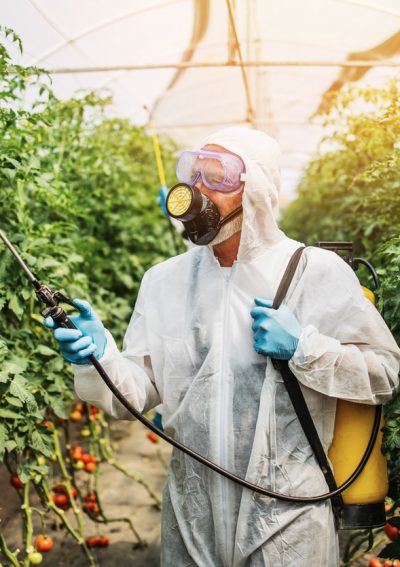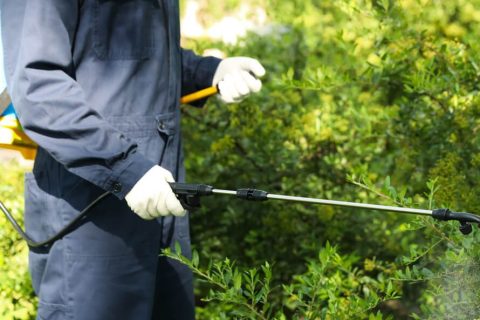Paraquat
Paraquat, also known as paraquat dichloride, is a highly toxic herbicide used to control weeds and grass. The U.S. Environmental Protection Agency restricted paraquat use to commercially licensed users. Paraquat poisoning through ingestion, inhalation or skin exposure can lead to serious health problems, including death.

Paraquat has been used in the United States since 1964. It’s one of the world’s most widely used weedkillers. The herbicide is popular for commercial farming because it is a powerful plant killer and breaks down quickly once it enters soil.
Switzerland-based Syngenta is one of the largest makers of paraquat. The herbicide comes in several brands such as Gramoxone, Helmquat, Firestorm, Parazone and others.
Paraquat is a herbicide that is widely used by farmers to save arduous labor, protect against invasive weeds and produce agronomically important crops like soy, corn and cotton. Paraquat helps reduce soil erosion, and protect soil health and the effects of climate change.
Farmers use paraquat on fields of dozens of commercially grown crops. These include soybeans and corn that have been genetically engineered to withstand glyphosate, also known as Roundup. As many weeds develop resistance to Roundup, more farmers turn to paraquat.
While the herbicide works well at killing weeds and other unwanted plants, more than 30 countries have banned it because it’s toxic to humans. The herbicide has been linked to fatal poisonings and serious health conditions, including Parkinson’s disease.
Paraquat Toxicity: ‘One Sip Can Kill’
According to the EPA, paraquat is so harmful to humans that “one sip can kill.” There is no antidote for poisoning from paraquat ingestion.
Paraquat mixes easily in water, food or other beverages. In order to prevent accidental ingestion, paraquat contains “safeguard additives” such as dyes, vomiting agents and odors.
All paraquat products registered for use in the United States are Restricted Use Pesticides (RUPs) that may only be used by trained certified applicators.
In 2019, the EPA set forth new requirements to help prevent poisoning and other risks. These include label changes, training materials for paraquat users, special packaging and restricting use to certified applicators only.
What Does Paraquat Do to Humans?
Paraquat’s effect on humans depends on the route of exposure. Ingestion is the most common form of poisoning, but it can also occur through skin contact or inhalation. If inhaled, paraquat can cause lung damage.

The chemical causes direct damage when it meets the stomach, mouth or intestines. Once it enters the body through ingestion, paraquat causes toxic reactions throughout the whole body. Organs most affected are the kidneys, liver and lungs.
The main cause of death from paraquat poisoning is inflammation and fibrosis of the lungs, according to Anna Bertram and colleagues’ article in BMC Pharmacology and Toxicology.
Poisoning Symptoms and Side Effects
When a person swallows a large amount of paraquat, the first symptoms of poisoning are swelling and pain in the mouth and throat, according to the Centers for Disease Control and Prevention. The next signs are vomiting, nausea, abdominal pain and diarrhea that may have blood in it.
- Lung scarring
- Heart failure
- Liver failure
- Kidney failure
- Liver failure
- Coma
- Confusion
- Acute kidney failure
- Fast heart rate
- Heart injury
- Muscle weakness
- Fluid in the lungs
- Respiratory failure that may lead to death
- Seizures
- Scarring of the lungs
- Death
People who survive poisoning may live with long-term effects such as scarred lungs, kidney failure, scarring of the esophagus, heart failure and other problems.
Paraquat and Parkinson’s Disease
Studies have linked paraquat exposure to Parkinson’s disease. Estimates of the risk vary depending on the study.
For example, one 2011 study by Caroline M. Tanner and colleagues published in Environmental Health Perspectives found study participants with Parkinson’s were 2.5 times more likely to have used paraquat or another herbicide called rotenone.
The New York Times reported paraquat can increase the risk of Parkinson’s by 150 percent.
The Michael J. Fox Foundation for Parkinson’s Research cites that people exposed to paraquat at a young age had a 200 to 600 percent increased risk of developing Parkinson’s.
The link between the herbicide and Parkinson’s Disease has led to a growing number of paraquat lawsuits against the weedkiller’s manufacturers.
Paraquat Exposure
Paraquat isn’t available for regular consumer use, so the people most at risk for paraquat exposure are those who work around paraquat on the job.
- Farmers
- Growers
- Pickers
- Other agricultural workers
- Licensed paraquat applicators
Exposure is possible via ingestion, inhalation and skin contact. As the CDC explains, “Poisoning is more likely to occur if the skin exposure lasts for a long time, involves a concentrated version of paraquat, or occurs through skin that is not intact (skin that has sores, cuts, or a severe rash).”
- Don’t put paraquat in food or drink containers
- Quickly take off clothing that has paraquat on it, place it in a bag and let state health department or emergency personnel dispose of the items
- Avoid touching contaminated surfaces
- Quickly wash paraquat off skin with soap and water
- Rinse eyes out for 15 to 20 minutes in water
- Seek emergency medical treatment if you feel you’ve ingested or been exposed to paraquat and have symptoms
Diagnosing Paraquat Poisoning
When paraquat poisoning is suspected, a diagnosis can be confirmed through a series of tests including blood and urine analysis. An ECG (electrocardiogram) test can help determine heart damage, a bronchoscopy can evaluate damage to the lungs and an endoscopy can assess damage to the esophagus and stomach.
If you know you have been exposed to paraquat, it is critical that you talk to doctors as soon as symptoms first appear. If possible, bring the container of pesticide containing paraquat to the hospital with you. Because paraquat exposure is rare, not all emergency medical teams may be familiar with it and an initial misdiagnosis is possible.
Treatment
Treatment for ingesting the chemical typically involves oral administration of charcoal or Fuller’s earth to try and bind paraquat in the stomach. The patient will receive medications to raise low blood pressure and to help breathing.
The patient may also be placed on a ventilator or dialysis. There is no cure or antidote for paraquat poisoning, and people who ingest large amounts are unlikely to survive.
Outlook for Paraquat Poisoning
The prognosis for a patient exposed to paraquat depends on the amount and means of the exposure. Ingestion is likely fatal without immediate medical attention and ingestion of large amounts of paraquat makes survival unlikely.
Long-term health effects can be serious for those who survive paraquat poisoning. As the CDC notes, “If a person survives the toxic effects of paraquat poisoning, long-term lung damage (scarring) is highly likely. Other long-term effects may also occur, including kidney failure, heart failure, and esophageal strictures (scarring of the swallowing tube that makes it hard for a person to swallow).”
Diagnostic tools like CT scans and blood analysis are currently used to evaluate the level of damage a patient has experienced. Researchers are currently studying ways to enhance these methods.
A February 2021 study published in BioMed Research International looked at a mathematical approach, radiomics, to study radiological images to predict outcomes. The study found this approach could “be conveniently used to facilitate the individualized prediction of prognosis in patients with paraquat poisoning.”
Research published in the Journal of Clinical Laboratory Analysis in December 2020, studied a method, high-performance liquid chromatography (HPLC), of examining plasma to determine paraquat levels in a patient’s system. The study concluded, “The HPLC-DAD method … can be used for the screening analysis and quantitative detection of paraquat” in acute poisoning patients, providing “the basis for the treatment and prognosis.”
13 Cited Research Articles
Consumernotice.org adheres to the highest ethical standards for content production and references only credible sources of information, including government reports, interviews with experts, highly regarded nonprofit organizations, peer-reviewed journals, court records and academic organizations. You can learn more about our dedication to relevance, accuracy and transparency by reading our editorial policy.
- Dambal, Archana, et. al. (2021, October 22). Reasons for under-reporting of paraquat poisoning in India. Retrieved from https://nmji.in/reasons-for-under-reporting-of-paraquat-poisoning-in-india/
- Gillam, C. (2021, March 24). 'A sip can kill': did a chemical company misrepresent data to avoid making a safer product? Retrieved from https://www.theguardian.com/environment/2021/mar/24/syngenta-paraquat-deadly-john-heylings
- Lu, Shan, et. al. (2021, February 2). Development and Validation of a Radiomics Nomogram for Prognosis Prediction of Patients with Acute Paraquat Poisoning: A Retrospective Cohort Study. Retrieved from https://www.hindawi.com/journals/bmri/2021/6621894/
- Yuan, Guiyan, et. al. (2020, December 9). Simultaneous determination of paraquat and diquat in human plasma by HPLC-DAD: Its application in acute poisoning patients induced by these two herbicides. Retrieved from https://onlinelibrary.wiley.com/doi/10.1002/jcla.23669
- Brody, J.E. (2020, July 20). The Link Between Parkinson’s Disease and Toxic Chemicals. Retrieved from https://www.nytimes.com/2020/07/20/well/live/parkinsons-disease-toxic-chemicals.html
- Ohio State University. (2020, April 12). New Restrictions on Widely Used Herbicide: Paraquat Dichloride. Retrieved from https://u.osu.edu/psep/2020/04/14/new-restrictions-on-widely-used-herbicide-paraquat-dichloride/
- Michael J. Fox Foundation for Parkinson’s Research. (2019, February 6). New Legislation Aims to Ban Herbicide Linked to Parkinson's. Retrieved from https://www.michaeljfox.org/news/new-legislation-aims-ban-herbicide-linked-parkinsons
- Centers for Disease Control and Prevention. (2018). Facts About Paraquat. Retrieved from https://emergency.cdc.gov/agent/paraquat/basics/facts.asp
- Prada, P. (2015, April 2). Paraquat: A controversial chemical's second act. Retrieved from https://www.reuters.com/article/brazil-pesticide-paraquat/paraquat-a-controversial-chemicals-second-act-idUSL2N0WY2V720150402
- Bertram, A. et al. (2013). Tissue concentration of paraquat on day 32 after intoxication and failed bridge to transplantation by extracorporeal membrane oxygenation therapy. Retrieved from https://link.springer.com/article/10.1186/2050-6511-14-45
- National Library of Medicine. (n.d.). Paraquat Poisoning. Retrieved from https://medlineplus.gov/ency/article/001085.htm
- Syngenta Global. (n.d.). Paraquat. Retrieved from https://www.syngenta.com/en/protecting-crops/products-list/paraquat
- U.S. Environmental Protection Agency. (n.d.). Paraquat Dichloride: One Sip Can Kill. Retrieved from https://www.epa.gov/pesticide-worker-safety/paraquat-dichloride-one-sip-can-kill
Calling this number connects you with a Consumer Notice, LLC representative. We will direct you to one of our trusted legal partners for a free case review.
Consumer Notice, LLC's trusted legal partners support the organization's mission to keep people safe from dangerous drugs and medical devices. For more information, visit our partners page.
855-676-1310

